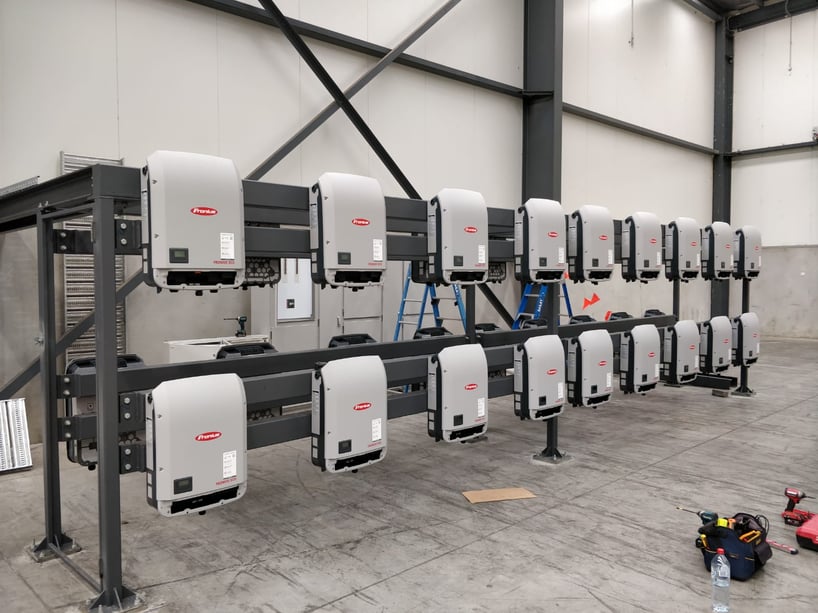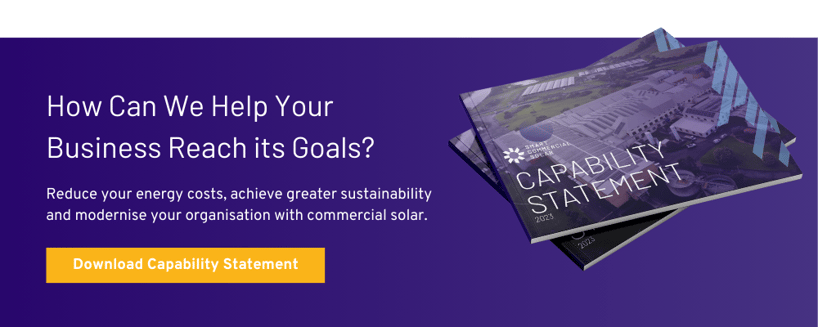The global solar inverter market is currently undergoing a remarkable expansion, spurred on by a growing demand for renewable energy and transformative innovations.
Manufacturers are competing through innovation, resulting in models which offer higher efficiency, better reliability, and more user-friendly features than ever before. Combined with advancements in PV technology, today’s solar inverters are improving system outcomes for residential, commercial, and industrial projects.
This Smart Guide will take you through the pivotal role of an inverter in a solar power system, the different types available and future forecasts for this exciting sector.
Solar Inverters: A Key Piece of the Puzzle
Inverters play a crucial role in efficiently converting solar energy into usable power. They work by converting the variable direct current (DC) output of a PV solar panel into a utility-frequency alternating current (AC) that can be used by your home or commercial premises. In addition, they’re used to track voltage, enable communication with the grid, and can shut off in an emergency.
Australia has bold clean energy goals – by 2030, we’re aiming to source 82% of our energy from renewables, with solar power slated to supply over half of that[1]. Worldwide, it’s estimated that renewable energy will make up 77% of the world's primary energy supply by 2050. To achieve this target, the deployment of renewable energy must triple from 2022 levels by 2030, which amounts to an annual addition of 1,200 gigawatts.[2]
Without the rapid deployment of cutting-edge solar and storage systems – of which inverters are a critical element – the global transition to clean energy simply can’t happen in time to meet climate deadlines.

The Solar Inverter Market
The acceleration of renewable energy deployment has a direct impact on the solar inverter market. As a result, it has experienced substantial growth in recent years: from $15.08 billion in 2023, it is predicted to reach $16.91 billion in 2024, with forecasts projecting further expansion to $26.06 billion by 2028[1].
The Asia-Pacific region is a major driver of this growth - in 2023, it was both the largest market and the fastest-growing region. Government support to meet clean energy goals has played a role in this demand as it has in Europe and the United States, helping to bolster global PV inverter shipments to 333GW in 2022.
In terms of manufacturers, the world’s top ten currently account for over 80% of the total market share.[2] Chinese giants Huawei dominate with a global market share of 29%, while Sungrow increased its market share by 23% to remain in second place.
Here in Australia, Austrian firm Fronius continues to dominate with around 23% market share. In 2022, Fronius invested EUR 187 million in the expansion and conversion of its production site in Sattledt, with production “running constantly at full speed in order to cover the enormously increased demand in the best possible way,” according to Martin Hackl, Global Director of Marketing and Sales.[3]
Your Guide to Inverter Types
Microinverters
Microinverters are small electronic devices that operate at the panel level rather than at a system level, making them ideal for partially shaded conditions. When installed on individual solar panels they optimize power independently and enable panel-by-panel monitoring for swift troubleshooting. Downsides include higher cost (about 40-50% more than high-quality string inverters) and vulnerability to extreme weather, given their rooftop location.
String Inverters
Centralized and cost-effective, string inverters are suitable for installations with unobstructed sunlight. Each inverter is connected with a string of solar panels – the exact number of panels varies depending on a number of factors including the wattage rating – and converts the DC energy produced into AC current for the entire string. This means if one panel is damaged, dirty or shaded, the entire system output is reduced.
Power optimisers
Power optimisers are installed at the module level like microinverters to optimise the power output of each solar panel. They mitigate the effects of shading, soiling, and panel mismatch, resulting in increased energy yields. Additionally, they provide real-time monitoring and advanced analytics, allowing for proactive maintenance and system optimization.
Smart inverters
Smart inverters are advanced inverters equipped with intelligent features that enable seamless integration with the electrical grid. They can communicate with the grid, adjust their power output according to grid conditions, and contribute to grid stability. Smart inverters also offer enhanced safety features, such as automatic shutdown during a grid outage, protecting utility line workers.
Off-grid inverters
Off-grid solar inverters are specifically designed for standalone solar power systems which are not connected to the electrical grid. They convert solar-generated DC electricity into AC for use in locations without grid access. Unlike grid-tie inverters, off-grid inverters incorporate battery charging to store excess energy, ensuring a continuous power supply during periods of low sunlight. They often include features for load management, voltage regulation, and compatibility with backup generators.
Grid-tie inverters
This category of inverter synchronises the solar power output with the grid's voltage and frequency, allowing excess electricity to be exported to the grid. This enables users to offset their electricity consumption and, in some cases, receive credits for the energy they contribute. Grid-tie inverters can be microinverters (modular) or strong inverters (centralized).
Hybrid system inverters
A hybrid solar inverter is a piece of equipment that is created by combining a solar inverter and a battery inverter into a single unit. This allows the hybrid solar inverter to intelligently handle power coming from your solar panels, solar batteries, and the utility grid all at the same time. With the increased adoption of battery energy storage systems (BESS), adoption is likely to increase in these inverters.
Battery inverters
Battery inverters play a crucial role in energy storage systems, enabling users to store excess solar energy for later use. They manage the charging and discharging of batteries, ensuring optimal performance and efficiency. Coupling solar panels with battery storage allows for greater energy independence, resilience, and backup power during emergencies.
Innovations in Inverters
The role of AI
AI is revolutionizing solar inverters by enabling advanced predictive maintenance. Machine learning algorithms optimise performance by identifying and addressing issues in real-time. The integration of AI enhances overall system efficiency, contributes to the longevity of solar installations, and propels the industry into a new era of intelligent energy management.
Monitoring and control systems
To fully optimise solar energy systems, monitoring and control systems are essential. These systems enable real-time monitoring of solar energy production, consumption, and grid interaction. Users can track energy generation and consumption patterns, identify potential issues, and optimise performance with remote monitoring and troubleshooting capabilities.
As solar energy gains momentum as a viable and sustainable energy source, the role of inverters becomes increasingly crucial. The latest inverter innovations, coupled with the integration of AI, are transforming the solar energy industry by enhancing energy efficiency, improving system monitoring, and enabling greater energy independence. From advancements in monitoring and control systems to the development of smart inverters and the utilisation of AI for predictive maintenance, the future holds exciting possibilities for the solar energy landscape.
[1] The 82 per cent national renewable energy target – where did it come from and how can we get there? (energycouncil.com.au)
[2] Turning the tide in scaling renewables report - KPMG Global
[3] Solar Inverter Market Anticipates Robust Growth with Technologies Advancing and Asia-Pacific Leading Regionally (yahoo.com)
[4] Who are the world's top 10 solar inverter makers and where are they shipping? - One Step Off The Grid
[5] Solar inverter market in 2023 - a closer look (power-and-beyond.com)




